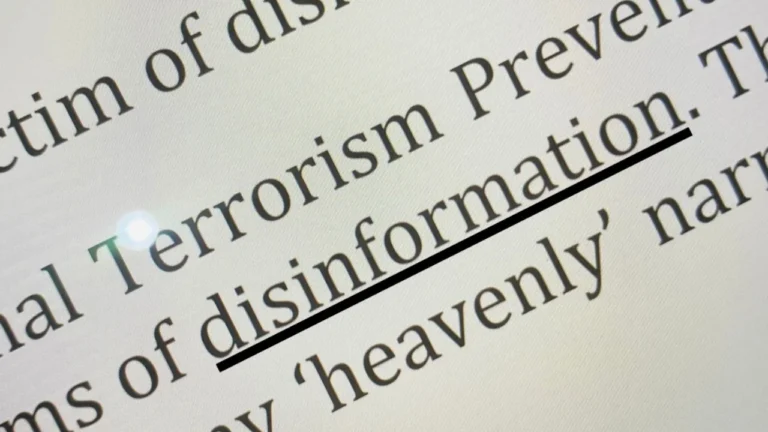Radicalization Through Disinformation

In 2014, a photo circulated of Abu Bakar Baasyir, a salafi jihadi figure believed to have links to the Al Qaeda terrorism network, sitting with ISIS (Islamic State of Iraq and Syria) figures, such as Abu Husna and Abu Yusuf against the backdrop of the ISIS flag. At that time, Abu Bakar Baasyir, familiarly called Ustadz Abu, was serving his sentence in Pasir Putih prison, Nusakambangan, Cilacap, Central Java.
The circulation of the photo made the public wonder whether it was true that Ustadz Abu had pledged allegiance to ISIS. Sofyan Tsauri, a former terrorism convict who also had links to Al Qaeda’s Southeast Asian terrorism network, said that Baasyir trusted Abu Walid too much about Syria. Abu Walid was one of Baasyir’s students sent by him to find out about ISIS. In the end, Abu Walid was known to have pledged allegiance to ISIS and became one of Abu Bakr Al Baghdadi’s confidants, the former leader of ISIS.
After his release on Friday, January 8, 2021, Baasyir met many moderate Islamic figures. Baasyir’s son, Abdur Rohim Baasyir, said that his father is not harsh as he used to be, especially on matter related to ISIS.
“As we always say, Ustadz Abu is more a victim of disinformation,” Rohim said.
The Director of Prevention of the National Terrorism Prevention Agency (BNPT), Prof. Irfan Idris, said that it was true that they were victims of disinformation. They are exposed to narratives spread through social media. According to him, many ‘heavenly’ narratives are indeed spread by terrorist groups to lure their targets.
“These narratives are indeed raised to find victims,” said Irfan.
According to Irfan, there are three things that terrorist groups never stop doing, namely recruiting, funding, and conducting training. “Those who are active are recruiting offline and online. If the Bali bombing was still offline, so that those recruited still have a close relationship (family). Now there is social media, so now there is the term ‘lone wolf’,” explained Irfan.
These narratives flood the internet, both through social media and the dark web. The narrative that is spread is packaged with attractive form and often resembles advertisements and uses familiar jargon. As exemplified by Irfan with the sentence, ‘whatever the organization is, the goal is the caliphate’ which resembles an Indonesian drink advertisement.
Meanwhile, the misdirection of the narrative carried out includes on how they interpret jihad. Like the appeal to women, if they are incapable of jihad by means of war, then biological jihad alone is defined by serving the passions of militants.
“They do it because of the promise of heaven, which leads to disinformation. They issue the narrative based on their own interpretation, which they consider as the most correct interpretation, while people do not have strong immunity, so they are easily tempted and exposed,” said Irfan.
Malaysian countering violent extremism expert, Ahmad El Muhammady, stated that the same thing happens in Malaysia. “In most cases, they are victims of disinformation and propaganda. The information they received is crafted to attract a certain audience,” he said.
He added, “In cases found in Malaysia, all returning families reported that they came to Syria because of attractive offers of a comfortable life under IS rule, with job opportunities, good salaries, an Islamic way of life, and justice. When they arrived there, it was the opposite situation.”
When IS declared the caliphate in 2014, IS leader Abu Bakar al-Baghdadi invited people of different expertise came to join their ranks and to serve under so called the caliphate, with the promise that they would have good life under the rule of shariah. Many people fall to this narrative and they thronged to join IS in Iraq and Syria. As we all know, many regretted later when they realized that it was just a ruse.
A young Malaysian man who just got married with small kid was forced to become suicide bomber, leaving his grieving wife with small kid. Now the wife was pleading to Malaysian government to take her and her kids back home.
According to Ahmad, they also have one Malaysian lady who were lured by IS recruiter that she befriended online. The recruiter bought her a return ticket from Kuala Lumpur to Istanbul, and promised that she can just leave if she doesn’t like the place. However, she said, the moment she crossed the Turkish border to Syria, she knew there is no turning back. She regretted leaving Malaysia and now pleading to return home. That was the anatomy of disinformation and lies IS was propagating.
But then, Irfan reminded that these disseminated narratives can not be said to be the main cause of exposure but rather because they already have triggers that make them look for these narratives.
“Those terrorist groups, whether sympathizers, militants, or hardcore, are not the narrative they were exposed to. There is already a seed in them, for example, disappointment that influences them to then look for a narrative. The narrative is only complementary, not a compelling reason,” he told The Apex Chronicles.
This was acknowledged by Ika Puspitasari, who indeed began to look for various narratives related to jihad after the bombing at the Bethel Injil Sepenuh Church (GBIS) Kepunton, Surakarta, Central Java, on September 25, 2011, which killed the perpetrators of the bombing itself and wounded 24 others. Ika, who later worked as an Indonesian migrant worker in Hong Kong, then began looking for various pieces of information related to the bombing.
Despite working as a migrant worker, Ika had quite a lot of free time to explore various narratives and find out about the group involved behind the GBIS Kepunton suicide bombing. She then read many websites that contained information about Muslim in Palestine, Uyghur Muslims, and the Arab Spring.
“I knew the FPI first, then HTI (Hizbut Tahrir Indonesia), which both did not mention about amaliyah (action, such as suicide bombing), only later after finding a website about Jabal Al Nusra (a militant group affiliated with Al-Qaeda), I started to get involved further more,” Ika said.
Ika’s transformation happened quickly due to high exposure on social media. She helped fund movements linked to terrorism network and planned her own ‘amaliyah’ to detonate suicide bombs in Bali. She was arrested by the Anti-Terrorism Special Detachment (Densus 88) before her mission was carried out.
Ika Puspitasari is a former terrorism convict who was charged as a financier and initiator of terror acts to the headquarters of Shia Ijabi (Ikatan Jamaah Ahlul Bait Indonesia) in Bandung with a sentence of 4,5 years in prison. She said that she was also a victim of disinformation. She only realized that much of the information she received was not in accordance with the actual conditions that occurred, especially in Indonesia, before her release when she met with prisoners who had declared their intention to return to the Unitary State of the Republic of Indonesia (NKRI).
“They said, Indonesia is Darul Kufri, the majority of the people are muslim, and there is no prohibition whatsoever to do worship in this country. For Shia, there is no prohibition. There is no problem here in Indonesia, the problem is us,” said Ika.
To avoid exposure to narratives from alluring terror groups that flood the digital world, Irfan said that what can be done is to flood the digital channels with reverse content or so-called alternative narratives.
“Like the dining table, the menu choices presented are radicalism and extremism. We should provide other menus, alternative menus,” said Irfan.
The alternative menus referred to by Irfan are moderating narratives to neutralize bombastic illusory narratives, including by using narratives that ground local wisdom. The weakness is that these narratives only minimize the influence, so that someone does not change too much.
Based on data owned by BNPT, during 2022, more than 600 sites and social media platforms containing radical elements were found with more than 900 propaganda contents. “We can’t forbid someone from reading certain narratives, we only try to minimize them with alternative narratives,” said Irfan.



